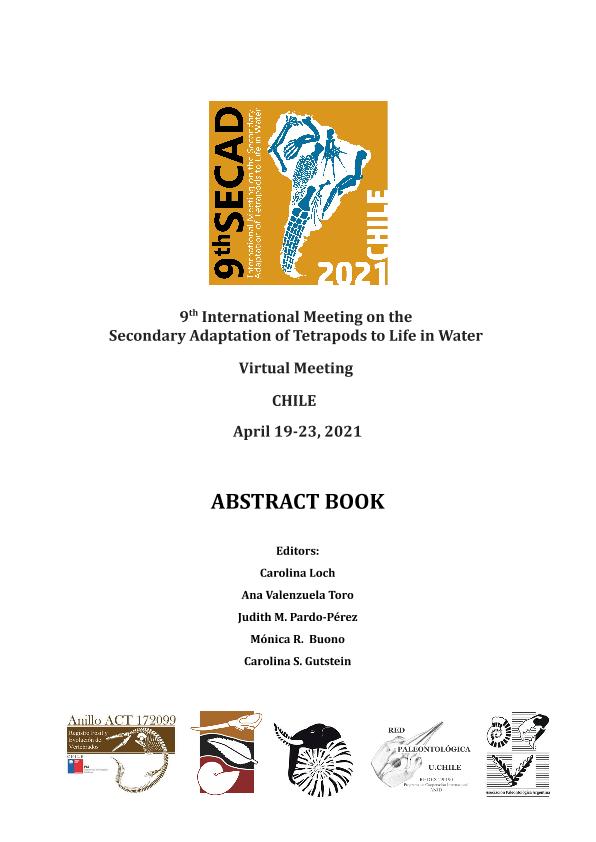Evento
Paleoecology and taphonomy of Neogene cetaceans: New perspectives from the southwestern Atlantic Ocean
Buono, Mónica Romina ; Cuitiño, José Ignacio
; Cuitiño, José Ignacio ; Viglino, Mariana
; Viglino, Mariana ; Paolucci, Florencia
; Paolucci, Florencia ; Gaetán, Carlos Maximiliano
; Gaetán, Carlos Maximiliano ; Farroni, Nicolás Daniel
; Farroni, Nicolás Daniel ; Bessone, Santiago
; Bessone, Santiago
 ; Cuitiño, José Ignacio
; Cuitiño, José Ignacio ; Viglino, Mariana
; Viglino, Mariana ; Paolucci, Florencia
; Paolucci, Florencia ; Gaetán, Carlos Maximiliano
; Gaetán, Carlos Maximiliano ; Farroni, Nicolás Daniel
; Farroni, Nicolás Daniel ; Bessone, Santiago
; Bessone, Santiago
Tipo del evento:
Reunión
Nombre del evento:
9th International Meeting on the Secondary Adaptation of Tetrapods to Life in Water
Fecha del evento:
19/04/2021
Institución Organizadora:
Universidad de Chile. Departamento de Biología. Red Paleontológica;
Consejo Nacional de Investigaciones Científicas y Técnicas. Centro Científico Tecnológico Conicet - Centro Nacional Patagónico. Instituto Patagónico de Geología y Paleontología;
Universidad de Magallanes. Centro de Investigación GAIA-Antártica;
Universidad Austral;
University of Otago. Department of Oral Sciences;
University of California Santa Cruz. Department of Ecology and Evolutionary Biology;
Asociación Chilena de Paleontología;
Título del Libro:
9 th International Meeting on the Secondary Adaptation of Tetrapods to Life in Water: Virtual Meeting
Editorial:
Asociación Chilena de Paleontología
Idioma:
Inglés
Clasificación temática:
Resumen
The Neogene was a key time for cetaceans diversification and cosmopolitan distribution, mainly driven by important changes in global climate and ocean productivity. Neogene deposits from the Atlantic and Pacific Oceans and the Mediterranean and North Seas provide a rich cetacean fossil record from this critical evolutionary time. In the Southwestern Atlantic Ocean, Miocene outcrops in Patagonia (Argentina) hold an important, albeit still poorly known, fossil record of modern lineages (= Neoceti) which in the last ten years have been continuously and exhaustively explored from a systematic, paleoecological, and taphonomic points of view. The most fossiliferous cetacean’s outcrops comprise the lower Miocene Gaiman Formation, the upper Miocene Puerto Madryn Formation, and the Bajo del Gualicho Formation of uncertain Miocene age. Numerous specimens were collected in the XIX century, and many have been recently studied taxonomically and anatomically. Modern fieldwork efforts have resulted in new and more well-preserved specimens, increasing the taxonomic diversity of the assemblage but also the taphonomic and paleoecological information.
Palabras clave:
CHUBUT
,
TAPHONOMY
,
ODONTOCETI
,
MIOCENE
,
RIO NEGRO
,
MYSTICETI
Archivos asociados
Licencia
Identificadores
Colecciones
Eventos(CCT - LA PLATA)
Eventos de CTRO.CIENTIFICO TECNOL.CONICET - LA PLATA
Eventos de CTRO.CIENTIFICO TECNOL.CONICET - LA PLATA
Eventos(IPGP)
Eventos de INSTITUTO PATAGONICO DE GEOLOGIA Y PALEONTOLOGIA
Eventos de INSTITUTO PATAGONICO DE GEOLOGIA Y PALEONTOLOGIA
Citación
Paleoecology and taphonomy of Neogene cetaceans: New perspectives from the southwestern Atlantic Ocean; 9th International Meeting on the Secondary Adaptation of Tetrapods to Life in Water; Santiago de Chile; Chile; 2021; 18-18
Compartir



